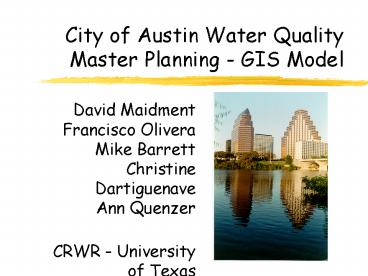City of Austin Water Quality Master Planning GIS Model - PowerPoint PPT Presentation
1 / 55
Title:
City of Austin Water Quality Master Planning GIS Model
Description:
City of Austin Water Quality Master Planning GIS Model – PowerPoint PPT presentation
Number of Views:179
Avg rating:3.0/5.0
Title: City of Austin Water Quality Master Planning GIS Model
1
City of Austin Water QualityMaster Planning -
GIS Model
- David MaidmentFrancisco Olivera Mike Barrett
Christine DartiguenaveAnn Quenzer - CRWR - University of Texas
2
OVERVIEW
- The study area
- DEM-based topographic analysis
- GIS-based hydrologic analysis
3
- The Study Area
4
LOCATION MAP
5
LAND USE
6
WATERSHEDS
7
EDWARDS AQUIFER
8
BMPS
9
CONTROL POINTS
10
- DEM-Based Topographic Analysis
11
USGS 7.5 QUADRANTS OF THEAUSTIN AREA
12
DIGITAL ELEVATION MODEL (DEM)
13
HYDROLOGIC (RASTER-)GIS FUNCTIONS
14
FLOW DIRECTION
- Water flows to one of its neighbor cells
according to the direction of the steepest
descent. - Flow direction takes one out eight possible
values.
15
FLOW ACCUMULATION
- Flow accumulation is an indirect way of measuring
drainage areas (in units of grid cells).
16
STREAM DEFINITION
- All grid cells draining more than 250 cells
(user-defined threshold) are part of the stream
network.
17
STREAM SEGMENTATION
- Stream segments (links) are the sections of a
stream channel connecting two successive
junctions, a junction and the outlet, or a
junction and the drainage divide.
18
WATERSHED DELINEATION
- All grid cells flowing towards a specific stream
segment (link) constitute its watershed or
drainage area. - The watershed grid is then converted from raster
into vector.
19
BURNING-IN PROCESS
20
DELINEATED STREAMS OF THEAUSTIN AREA
21
DELINEATED WATERSHEDS OF THEAUSTIN AREA
22
LOCATION OF CONTROL POINTS
23
- GIS-Based
- Hydrologic Analysis
24
VECTOR AND RASTERREPRESENTATIONS OF THE TERRAIN
Vector representation
Raster representation
The parameter represented can be land use,
impervious cover, runoff coefficient, EMC...
25
IMPERVIOUS COVER VS. LAND USE
26
CURRENT IMPERVIOUS COVER
27
FUTURE IMPERVIOUS COVER
28
EQUATION FOR ESTIMATINGANNUAL LOADS
- For each land surface cell (30m x 30m)Load
M/T Precip L/T Runoff Coeff Mean Conc
M/L3 Cell Area L2 - Load Direct Runoff Load Baseflow Load
- Use weighted flow accumulation to get downstream
loads - In channel, load is adjusted for
- groundwater recharge (flow and load decrease)
- channel erosion (load increase)
- Overall loads are adjusted for BMPs
29
DIRECT RUNOFF COEFFICIENT VS. IMPERVIOUS COVER
Data obtained at small watersheds. One point per
watershed per storm.
30
DIRECT RUNOFF COEFFICIENT VS. IMPERVIOUS COVER
Data obtained at small watersheds. One point per
watershed.
31
BASEFLOW COEFFICIENT VS.IMPERVIOUS COVER
32
EMCS VS. IMPERVIOUS COVER
- Estimation of individual storm EMC
- Estimation of watershed EMC
- Relating EMCs with impervious cover
33
NH3 CONCENTRATION VS.IMPERVIOUS COVER
34
TSS CONCENTRATION VS.IMPERVIOUS COVER
35
EMCS VS. IMPERVIOUS COVER
36
VOLUME OF WATERPRODUCED IN EACH CELL
37
MASS OF POLLUTANTPRODUCED IN EACH CELL
Mass of pollutant produced by each cell (M/L3)
Volume of water produced by each cell (L3/T)
EMC (M/L3)
38
VOLUME OF WATER LOST FROM EACHCREEK CELL OF THE
RECHARGE ZONE
recharge zone
L cell size
39
FLOW LOST IN THE RECHARGE ZONE
40
FLOW / LOAD
The flow (L3/T) and load (M/T) are calculated
with the weighted flowaccumulation function, as
the sum of the contributions from theupstream
cells.The same process is followed for direct
runoff and baseflow.
41
FLOW CALIBRATION
- For each gauged location (USGS stations),
observed flow and predicted flow (after recharge
zone correction) were compared. - For each station, and its corresponding drainage
area, a correction factor corrcoef was defined in
the following way
42
FLOW CORRECTION COEFFICIENT
- For the ungauged locations, the correction
coefficient is extrapolated according to their
impervious cover.
43
LOAD CALIBRATION
- For each gauged location (USGS stations),
observed load and predicted load (after recharge
zone correction) were compared. - For each station, it was assumed that the
difference in load values was produced by channel
erosion and a channel erosion coefficient was
defined (Kg/yr/ft).
44
LAND-GENERATEDPOLLUTANT CONCENTRATION
45
CHANNEL EROSION
- Apply the channel erosion equation to all
ungauged watersheds. - Add the channel erosion to the load at the
stations.
46
CONSTITUENTS THAT INVOLVECHANNEL EROSION
- Pure land contribution BOD, COD, DP, NH3, Cu,
Pb, Zn. - Land and channel contribution TSS, TOC, TP, TN.
47
- Construction Load and BMP Effect
48
CONSTRUCTION LOAD
- EMC(TSS) 600mg/L
- Direct runoff coefficient 0.5
49
LOCATED BMPSDEFINED BY LOAD REMOVAL
50
LOCATED BMPSDEFINED BY REMOVAL EFFICIENCY
51
LOCATED BMPSDEFINED BY REMOVAL EFFICIENCY
52
NON-LOCATED BMPS
53
NON-LOCATED BMPS
54
NON-LOCATED NON-DISCHARGE BMPS
Effective IC is used for calculating channel
erosion.
55
CONCLUSIONS
- The goal of this research project was to
determine current and future non-point source
pollution loads in Austin streams. - The model aims at being as flexible as possible
- The BMP parameters and the EMCs can be easily
modified and they do not require the analyst to
recalibrate the model - Modification of the current land use conditions,
of the precipitation value used, or of the
impervious cover/runoff coefficient relationships
will require recalibration of the model - The effects of both located and non-located
BMPs, and of construction activities were
modeled. - Current flows matching observed flows at 17 USGS
stations were determined - Loads were established for 122 sites
(Environmental Integrity Index sites, USGS
stations and mouths) within the study area.































